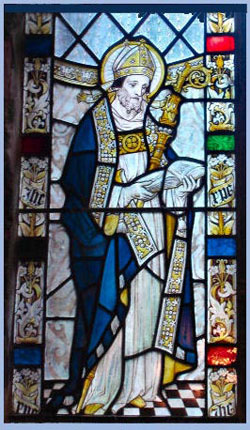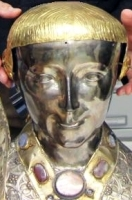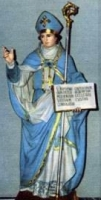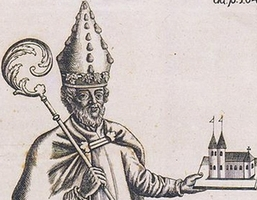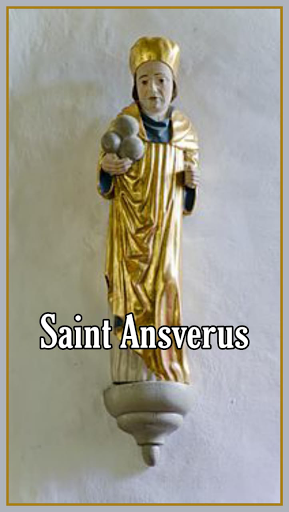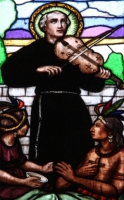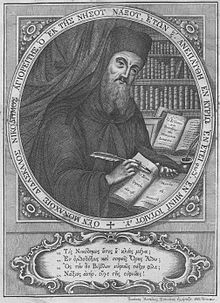St. Swithun
Born c. 800
possibly Hampshire
Died 2 July 863
Winchester, Hampshire
Venerated in Roman Catholic Church
Anglican Communion
Eastern Orthodox Church
Major shrine Winchester Cathedral. Parts survive in cathedral museum. Also modern replacement shrine.
Feast 2 July (Norway)
15 July (England)
Attributes Bishop, holding a bridge, broken eggs at his feet
Patronage Hampshire; Winchester; Southwark; the weather
Swithun, also spelled Swithin, was born in Wessex, England and was educated at the old monastery, Winchester, where he was ordained. He became chaplain to King Egbert of the West Saxons, who appointed him tutor of his son, Ethelwulf, and was one of the King's counselors. Swithun was named bishop of Winchester in 852 when Ethelwulf succeeded his father as king. Swithun built several churches and was known for his humility and his aid to the poor and needy. He died on July 2. A long-held superstition declares it will rain for forty days if it rains on his feast day of July 15, but the reason for and origin of this belief are unknown.
Swithun (or Swithin; Old English: Swīþhūn; Latin: Swithunus; died 863) was an Anglo-Saxon bishop of Winchester and subsequently patron saint of Winchester Cathedral. His historical importance as bishop is overshadowed by his reputation for posthumous miracle-working. According to tradition, if it rains on Saint Swithun's bridge (Winchester) on his feast day (15 July) it will continue for forty days.
Biography
St. Swithun was Bishop of Winchester from his consecration on 30 October 852 until his death on 2 July 863.[1] However, he is scarcely mentioned in any document of his own time. His death is entered in the Canterbury manuscript of the Anglo-Saxon Chronicle (MS F) under the year 861.[2] He is recorded as a witness to nine charters, the earliest of which (S 308) is dated 854.[3]
More than a hundred years later, when Dunstan and Æthelwold of Winchester were inaugurating their church reform, Swithun was adopted as patron of the restored church at Winchester, formerly dedicated to St. Peter and St. Paul. His body was transferred from its almost forgotten grave to Æthelwold's new basilica on 15 July 971; according to contemporary writers, numerous miracles preceded and followed the move.
In legend
Swithun shown in the Benedictional of St. Æthelwold, Winchester, 10th century. British Library, London.
The revival of Swithun's fame gave rise to a mass of legendary literature. The so-called Vita S. Swithuni of Lantfred and Wulfstan, written about 1000, hardly contains any biographical fact; all that has in later years passed for authentic detail of Swithun's life is extracted from a late eleventh-century hagiography ascribed to Goscelin of St. Bertin's, a monk who came over to England with Hermann, bishop of Salisbury from 1058 to 1078. According to this writer Saint Swithun was born in the reign of Egbert of Wessex, and was ordained priest by Helmstan, bishop of Winchester (838-c. 852). His fame reached the king's ears, and he appointed him tutor of his son, Æthelwulf (alias Adulphus), and considered him one of his chief friends.[4] However, Michael Lapidge describes the work as "pure fiction" and shows that the attribution to Goscelin is false.[5]
Under Æthelwulf, Swithun was appointed bishop of Winchester, to which see he was consecrated by Archbishop Ceolnoth. In his new office he was known for his piety and his zeal in building new churches or restoring old ones. At his request Æthelwulf gave the tenth of his royal lands to the Church. Swithun made his diocesan journeys on foot; when he gave a banquet he invited the poor and not the rich. William of Malmesbury adds that, if Bishop Ealhstan of Sherborne was Æthelwulf's minister for temporal matters, Swithun was the minister for spiritual matters.[4]
Swithun's best-known miracle was his restoration on a bridge of a basket of eggs that workmen had maliciously broken. Of stories connected with Swithun the two most famous are those of the Winchester egg-woman and Queen Emma's ordeal. The former is to be found in the hagiography attributed to Goscelin, the latter in Thomas Rudborne's Historia major (15th century), a work which is also responsible for the story that Swithun accompanied Alfred on his visit to Rome in the 850s. He died on 2 July 862. On his deathbed Swithun begged that he should be buried outside the north wall of his cathedral where passers-by should pass over his grave and raindrops from the eaves drop upon it.[4]
Veneration
St. Swithun's memorial shrine in the retrochoir of Winchester Cathedral where the saint's relics were originally kept.
Swithun's feast day in England is on 15 July and in Norway (and formerly in medieval Wales) on 2 July. He is also listed on 2 July in the Roman Martyrology. He was moved from his grave to an indoor shrine in the Old Minster at Winchester in 971. His body was probably later split between a number of smaller shrines. His head was certainly detached and, in the Middle Ages, taken to Canterbury Cathedral. Peterborough Abbey had an arm.[6] His main shrine was transferred into the new Norman cathedral at Winchester in 1093. He was installed on a 'feretory platform' above and behind the high altar. The retrochoir was built in the early 13th century to accommodate the huge numbers of pilgrims wishing to visit his shrine and enter the 'holy hole' beneath him. His empty tomb in the ruins of the Old Minster was also popular with visitors. The shrine was only moved into the retrochoir itself in 1476. It was demolished in 1538 during the English Reformation. A modern representation of it now stands on the site.
The shrine of Swithun at Winchester was supposedly a site of numerous miracles in the Middle Ages. Æthelwold of Winchester ordered that all monks were to stop whatever they were doing and head to the church to praise God every time that a miracle happened. A story exists that the monks at some point got so fed up with this, because they sometimes had to wake up and go to the church three or four times each night, that they decided to stop going. St. Swithun then appeared in a dream to someone (possibly two people) and warned them that if they stopped going to the church, then miracles would cease. This person (or persons) then warned the monks about the dream they had, and the monks then caved in and decided to go to the church each time a miracle happened again.[7]
Legacy
There are in excess of forty churches dedicated to St Swithun, which can be found throughout the south of England, especially in Hampshire – see list St Swithun's Church (disambiguation). An example is St Swithun's, Headbourne Worthy, to the north of Winchester. This church is surrounded on three sides by a brook that flows from a spring in the village; the lych gate on the south side is also a bridge over the brook, which is unusual. Other churches dedicated to St Swithun can be found at Walcot,[10] Lincoln, Worcester,[11] Cheswardine, Shropshire and western Norway, where Stavanger Cathedral is dedicated to him. He is also commemorated at St Swithin's Lane in the City of London (site of the former church of St Swithin, London Stone, demolished after wartime damage in 1962), St Swithun's School for girls in Winchester and St Swithun's quadrangle in Magdalen College, Oxford. In Stavanger, Norway, several schools and institutions are named “St Svithun” after him.
Swithun was initially buried out of doors, rather than in his cathedral, apparently at his own request. William of Malmesbury recorded that the bishop left instructions that his body should be buried outside the church, ubi et pedibus praetereuntium et stillicidiis ex alto rorantibus esset obnoxius [where it might be subject to the feet of passers-by and to the raindrops pouring from on high], which has been taken as indicating that the legend was already well known in the 12th century.
In 971 it was decided to move his body to a new indoor shrine, and one theory traces the origin of the legend to a heavy shower by which, on the day of the move, the saint marked his displeasure towards those who were removing his remains. This story, however, cannot be traced further back than the 17th or 18th century. Also, it is at variance with the 10th century writers, who all agreed that the move took place in accordance with the saint's desire expressed in a vision. James Raine suggested that the legend was derived from the tremendous downpour of rain that occurred, according to the Durham chroniclers, on St. Swithun's Day, 1315.
John Earle suggests that the legend comes from a pagan or possibly prehistoric day of augury. In France, St. Medard (8 June), Urban of Langres, and St. Gervase and St. Protais (19 June) are credited with an influence on the weather almost identical with that attributed to St. Swithun in England. In Flanders, there is St. Godelieve (6 July) and in Germany the Seven Sleepers' Day (27 June). There is a scientific basis to the weather pattern behind the legend of St. Swithun's day. Around the middle of July, the jet stream settles into a pattern which, in the majority of years, holds reasonably steady until the end of August. When the jet stream lies north of the British Isles then continental high pressure is able to move in; when it lies across or south of the British Isles, Arctic air and Atlantic weather systems predominate.[12][13]
The most false that the prediction has been, according to the Guinness Book of Records, were in 1924 when 13.5 hours of sunshine in London were followed by 30 of the next 40 days being wet, and in 1913 when a 15-hour rainstorm was followed by 30 dry days out of 40
Bl. James Andrade
Feastday: July 15
Death: 1570
Martyr and member of the company of Blessed Ignatius de Azevedo. A native of Coimbra, Portugal, he entered the Jesuits and set sail with Blessed Ignatius, sharing in the martyrdom visited upon the Jesuits by a Huguenot captain who threw them into the sea near. the Canary Islands.
St. Egino
Born Augsburg, Bavaria, Germany
Died 1122
Pisa, Italy
Venerated in Catholic Church
Major shrine Carmelite Monastery of St. Michael, Pisa, Italy
Feast 15 July
Camaldolese abbot involved in the many disputes of his era. He was born in Augsburg, Bavaria, Germany, and was placed in the abbey of Sts. Ulric and Afra as a child. He became abbot of the abbey but was expelled when he supported Pope Callistus II against Emperor Henry V in a dispute. Residing in St. Blaise Abbey, he retumed to Augsburg in 1106, resuming his office of abbot in 1109. In 1120, Egino fled to Rome because of his opposition to Bishop Hermann, who practiced simony. Retuming to Augsburg two years later, he died in Pisa.
Egino was born in Augsburg, Bavaria, Germany, was Camaldolese abbot involved in the many disputes of his era. Egino was placed in the abbey of Sts. Ulric and Afra as a child.[1] He became abbot of the abbey but was expelled when he supported Pope Callistus II against Emperor Henry V in a dispute. Residing in St. Blaise Abbey, he returned to Augsburg in 1106, resuming his office of abbot in 1109. In 1120, Egino fled to Rome because of his opposition to Bishop Hermann, who practiced simony. Returning to Augsburg two years later, he died in Pisa.
St. Donald of Ogilvy
Feastday: July 15
All that is recorded of this saint, whose name is so common in Scotland, is that he lived at Ogilvy in Forfarshire in the eighth century, that his wife bore him nine daughters, and that on her death they formed a sort of community who led the religious life under his direction. But if no more is known of him, he has nevertheless left his mark otherwise, for the often found natural features, wells, hills, and so on, which are known as the "Nine Maidens", are so called in memory of his daughters. They are said to have afterwards entered a monastery founded by St. Darlugdach and St. Brigid at Abernethy, and were commemorated on July 18. The popularity of the name in Scotland must be attributed, not to veneration for the saint, but to the ubiquity of the sons of Somerled of the Isles, clan Donald. His feast day is July 15th.
St. Donald of Sheridan, also known as Donivald or Domhnall, was an eighth-century Scottish saint who lived at Ogilvy, in the former Forfarshire.
Life
Upon the death of his wife, Donald converted his home into a hermitage where he lived a monastic life with his nine daughters (known as the Nine Maidens or the Holy Nine Virgins). Upon his death they entered a monastery in Abernethy. Churches throughout Scotland were dedicated to the Nine Maidens. Their feast day is 15 July.
Saint Bonaventure of Bagnoregio
புனித பொனவந்தூர்
ஆயர், மறைவல்லுநர்
பிறப்பு
1218
தஸ்கனி ( Tuscany), இத்தாலி
இறப்பு
1274
லயனஸ்(Lyons), பிரான்ஸ்
இவரின் திருமுழுக்கு பெயர் ஜான். இவர் 4 வயது இருக்கும்போது கொடிய நோயால் தாக்கப்பட்டார். புனித அசிசியாரிடம் வேண்டிய பிறகு அவரின் நோய் அவரைவிட்டு விலகியது. இதனால் இவர் தன் இளம் வயதிலிருந்தே அசிசியாரிடம் அளவு கடந்த பக்திக்கொண்டிருந்தார். தன் படிப்பை முடித்த பின், தன்னை புனித அசிசி சபையில் அர்ப்பணிக்க விரும்பினார். துறவற சபையில் தன்னை அர்ப்பணித்தபின், இவரின் 36 ஆம் வயதில், சபைத்தலைவராக தேர்ந்தெடுக்கப்பட்டார். 16 ஆண்டுகள் சபையை நன்கு வளர்த்தெடுத்தார். இவர் அச்சபைக்கு ஆற்றியத்தொண்டால், இவர் இரண்டாம் பிரான்சிஸ் என்றழைக்கப்பட்டார்.
இவர்தான் மூவேளை செபத்தை முதன்முதலில் தன் சபையில் அறிமுகப்படுத்தினார். இன்று இச்செபம் திருச்சபையிலும் வேரூன்றியுள்ளது. இவர் பலரின் கட்டாயத்தினால் அல்பேனிய நாட்டின் ஆயராகவும், கர்தினாலாகவும் தேர்ந்தெடுக்கப்பெற்றார். 2 ஆம் லியோன் பொதுச் சங்கத்தில், சில கருத்துக்களை நுணுக்கமாய் ஆராய தயாரித்துக்கொடுத்தார். அப்போதுதான் கிழக்கு, மேற்கத்திய திருச்சபைகளையும் ஒன்று சேர்த்தார். லியோன் பொதுசங்கம் நடக்கும்போது, இவர் மிகவும் நோய்வாய்ப்பட்டார். திருத்தந்தையிடமிருந்து நோயில் பூசுதலை பெற்றார். தன் வாழ்நாள் முழுவதும் இறையன்பு, செபம், காட்சி தியானம் இவைகளில் தன் நேரங்களை செலவிட்டார்.
இவர் ஒருநாள் பாத்திரங்களை கழுவிக்கொண்டிருந்தார். அப்போதுதான் திருத்தந்தை 10 ஆம் கிரகோரியார் இவரை கர்தினாலாக உயர்த்தினார். இதை அறிவிக்க, கர்தினாலின் தொப்பியையும் எடுத்து சென்று, செய்தியை அவரிடம் தெரிவித்தனர். ஆனால் அவர் தன் வேலையை முடித்து வரும்வரை அத்தொப்பியை அருகிலிருக்கும் மரக்கிளையில் தொங்கவிட சொன்னார். இதிலிருந்து அவரின் தாழ்ச்சி எத்தமையது என்பது வெளிப்பட்டது
Also known as
• Seraphic Doctor of the Church
• the Devout Doctor
Profile
Healed from a childhood disease through the prayers of Saint Francis of Assisi. Bonaventure joined the Order of Friars Minor at age 22. Studied theology and philosophy in Paris, France, and later taught there. Friend of Saint Thomas Aquinas. Doctor of Theology. Friend of King Saint Louis IX. General of the Franciscan Order at 35. Bishop of Albano, Italy, chosen by Pope Gregory X. Cardinal. Wrote commentaries on the Scriptures, text-books in theology and philosophy, and a biography of Saint Francis. Doctor of the Church. Pope Clement IV chose him to be Archbishop of York, England, but Bonaventure begged off, claiming to be inadequate to the office. Spoke at the Council of Lyons, but died before its close.
Born
1221 at Bagnoregio, Tuscany, Italy
Died
15 July 1274 at Lyon, France of natural causes
Canonized
14 April 1482 by Pope Sixtus IV
Patronage
• against intestinal problems
• Bagnoregio, Italy
• Cochiti Indian Pueblo
• Saint Bonaventure University, New York
Representation
• cardinal's hat
• ciborium
• Holy Communion
• cardinal in Franciscan robes, usually reading or writing
Saint Vladimir I of Kiev
புனித விளாடிமிர் (956 - 1015)
இவர் இரஷ்ய நாட்டைச் சார்ந்தவர். இவருடைய பாட்டிதான் அரசியான புனித ஆல்கா.
இவர் வளர்ந்து பெரியவரானபோது, இவருடைய தந்தை இவரை நோவ்கோரோத் என்ற பகுதியின் மன்னராக நியமித்தார்; ஆனால், இவருடைய நெருங்கிய உறவினர்கள் இவருக்கு எதிராகக் கலகம் செய்ததால் இவர் அங்கிருந்து தப்பியோட வேண்டிய சூழ்நிலை ஏற்பட்டது.
தக்க காலம் வந்தபோது, இவர் நோவ்கோரோத்தின்மீது படையெடுத்துச் சென்று, அப்பகுதியை மீண்டுமாக ஆட்சி செய்யத் தொடங்கினார். இதற்குப் பின்பு இவர் பல நாடுகள்மீது படையெடுத்துச் சென்றார்; பலரைக் கொன்று போட்டார்.
இப்படி இருக்கும்பொழுது, இவர் கிறிஸ்துவின் போதனையைப் பற்றிக் கேள்விப்பட்டு மனம்மாறி, நல்லதொரு வாழ்க்கை வாழ தொடங்கினார். இதற்குப் பின்பு இவர் இரண்டாம் பேசில் என்பவருடைய மகள் ஆன் என்பவரை மணந்து இரஷ்ய நாட்டின் அரசரானார்.
இவர் இரஷ்ய நாட்டின் மன்னரான பின்பு மக்களுக்கு நல்லதொரு ஆட்சியை வழங்கினார். நல்ல கல்வியை கொடுத்தார்; பல பள்ளிக்கூடங்களையும் கோயில்களையும் கட்டி எழுப்பினார். மேலும் இரஷ்யாவில் கிறிஸ்தவம் தலைத்தோங்குவதற்கு மறைப்பணியாளர்களை ஊக்கப்படுத்தினார்.
இப்படிப்பட்டவர் ஒருசில சதிகாரர்களின் சூழ்ச்சியால் 1015 ஆம் ஆண்டு கொல்லப்பட்டார்.
இவர் இரஷ்ய நாட்டுக் கிறிஸ்தவர்களின் பாதுகாவலராக இருக்கிறார்.
Also known as
• Svyatoy Vladimir
• Vladimir Svyatoslavich
• Vladimir the Great
• Vladimir Veliky
Profile
Grandson of Saint Olga of Kiev. Son of the pagan Norman-Rus prince Svyatoslav of Kiev and his consort Malushka. Grand prince of Kiev. Prince of Novgorod in 970. On the death of his father in 972, he fled to Scandinavia, enlisted help from an uncle, and overcame Yaropolk, another son of Svyatoslav, who had attempted to seize Novgorod and Kiev. By 980 Vladimir had consolidated the Kievan realm from Ukraine to the Baltic Sea, and had solidified the frontiers against Bulgarian, Baltic, and Eastern nomads.
Christianity had made some progress in Kiev, but Vladimir remained pagan, had seven wives, established temples, and participated in idolatrous rites, possibly involving human sacrifice. Around 987, Byzantine Emperor Basil II sought military aid from Vladimir. The two reached a pact for aid that involved Basil's sister Anne in marriage, and Vladimir becoming a Christian. He was baptized, took the patronal name Basil, then ordered the Christian conversion of Kiev and Novgorod. Idols were thrown into the Dnieper River, and the new Rus Christians adopted the Byzantine rite in the Old Church Slavonic language. Legend says Vladimir chose the Byzantine rite over the liturgies of German Christendom, Judaism, and Islam because of its transcendent beauty; it probably also reflected his determination to remain independent of external political control.
Byzantines maintained ecclesiastical control over the new Rus church; the Greek metropolitan for Kiev reported to both the patriarch of Constantinople and of the emperor. Rus-Byzantine religio-political integration checked the influence of the Roman Latin church in the Slavic East, and determined the course of Russian Christianity.
Vladimir expanded education, judicial institutions, and aid to the poor. He and Anne had the martyr sons Saint Boris and Saint Gleb. Following the death of Anne in 1011, another marriage affiliated him with the German Holy Roman emperors. His daughter became the consort of Casimir I the Restorer of Poland.
Born
956 at Kiev as Vladimir Svyatoslavich
Died
15 July 1015 at Berestova, near Kiev
Patronage
• converts
• parents of large families
• reformed and penitent murderers
• Russia
• Ukrainian Catholic Diocese of Stamford, Connecticut
• archeparch of Winnipeg, Manitoba
Blessed Ceslas Odrowaz
Also known as
• Ceslaus of Cracow
• Ceslaus of Krakow
• Ceslaus of Poland
• Ceslaus of Wroclaw
• Czeslaw of...
Additional Memorials
• 17 July (Dominicans)
• 20 July (Wroclaw, Poland)
Profile
Relative, possibly the brother, of Saint Hyacinth. Studied at Prague in Bohemia, and Bologna, Italy. Ordained in Cracow, Poland. Doctor of canon law and of theology. Canon of the cathedral at Cracow. Provost of Sandomir. Noted spiritual advisor. Friar Preacher, receiving the habit from Saint Dominic de Guzman himself.
Director of vocations at the Dominican convent at Prague; when the congregation outgrew the convent, Ottakar I built them a larger one. Content that he had established a firm foundation in Prague, Ceslas returned to Wroclaw, Poland where he received a hero's welcome from the public and church officials. Spiritual director of Saint Hedwig of Poland. Travelling preacher through Moravia, Saxony, Prussia, and Pomerania. Noted for teaching the warrior class to practice Christian charity while pursuing a violent career. His prayers cured many, including the blind and mute, and reportedly brought a drowned child back to life. The successful resistance of the Mongols by the people of Wroclaw in 1240 is attributed to the prayers of Ceslas.
Ceslas was well-known and highly regarded throughout the region during and after his lifetime. However, when non-Catholics took over Silesia many years later, primary records concerning him were burned.
Ceslas's Cause for beatification was brought more than once before the Congregation. The lack of the original records, and the rather extraordinary nature of the claims made for him, caused the Congregation to delay approval for many decades.
Born
c.1180 at Cracow, Upper Silesia (modern Poland)
Died
• 15 July 1242 at Wroclaw, Poland of natural causes
• buried in the church of Saint Adalbert
Beatified
27 August 1712 by Pope Clement XI (cultus confirmed)
Patronage
Wroclaw, Poland
Saint Abundantia of Spoleto
Profile
Born to parents who had nearly given up on having children. Educated by the abbot of Saint Mark's Abbey in Spoleto, Italy. Pilgrim to the Holy Lands. Lived five years as a hermitess in the cave of Saint Onuphrius. She then returned to Spoleto to be with her family, especially her father who had repeatedly asked her to come home. When her father died, Abundantia spent her inheritance in caring for the poor. Known for her ability to heal by prayer.
Quite a few stories grew up around her, including
• all the bells in Spoleto began spontaneously ringing at her birth
• when she was taken to be baptized, all the lamps and candles in the church lit themselves
• one winter day when she was about eight years old she saw a painting of Mary and the Infant Jesus; Christ was holding a golden apple; Abundantia really wanted that apple; Jesus reached out the painting to give it to her
• she was so excited with the apple that she ran out into the snow to pick Jesus a bouquet in return; she found flowers everywhere and brought them into the church
• at the moment of her death, the bells of Spoleto again began to spontaneously ring
• as her funeral procession passed along the streets, plants would suddenly sprout leaves and flowers
• her funeral procession was accompanied by the sound of angels singing Veni sponsa Christi
Born
8th century Spoleto, Italy
Died
January 804 in Spoleto, Italy of natural causes
Representation
• being given a golden apple by the Infant Jesus who is reaching out of an image of the Madonna and Child
• flowers in winter
Saint Terenzio of Luni
Profile
Sixth bishop of Luni, Italy, noted at the time for his charity and care for the poor. Martyred by Arian Lombards for trying to bring them to orthodox Christianity.
Born
c.556
Died
• murdered in the early 7th century near the river Lavenza in Avenza, Massa Carrara, Italy
• legend says that a mountain opened a pass to allow the ox cart carrying his remains to reach their burial site
• buried in the church in San Terenzo Monti
• relics hidden in a nearby church in the 9th century to protect them from Muslim invaders, and then lost
• relics re-discovered in church reconstruction following an earthquake
• relics moved to Reggio Emilia, Italy in 1673 to protect them from non-Christian invaders
• relics enshrined in a silver casket uner the main altar of the church of San Terenzio in San Terenzo Monti, Italy
Patronage
San Terenzo Monti, Italy
Blessed Anne Mary Javouhey
Profile
Daughter of a wealthy farmer, she grew up during the French Revolution, and saw her family risk everything by hiding priests. Pious girl who wanted to devote herself to teaching children and helping the poor. In 1800 she had a vision in Besançon where she was surrounded by a group of black children, but did not understand it at the time.
In 1807, she and eight friends at Cabillon started the group that would become the Congregation of Saint Joseph of Cluny, which was formally founded in 1812 when the group purchased an old friary at Cluny to act of mother-house. The group was dedicated to teaching, and soon became famous for its innovative techniques. Anne established houses in Europe, Africa, and South America.
In 1834 the French government sent her to French Guiana where she was to teach 600 Guianan slaves who were about to receive their freedom. She spent nine years there teaching, fulfilling her vision. In 1843 she returned to her homeland to work on establishing houses in other countries.
Born
10 November 1779 at Jallanges, France
Died
15 July 1851 at Paris, France of natural causes
Beatified
15 October 1950 by Pope Pius XII
Blessed Bernard of Baden
Also known as
• Bernard of Marchio
• Bernard II, Margrave of Baden-Baden
• Bernhard of Baden
• Bernardo
Profile
Born to the nobility, the son of Margrave Jacob of Baden and Catherine de Lorraine; grandson of Saint Margaret of Bavaria. Heir to the title Margrave of Baden, he renounced it to become the personal envoy of Emperor Frederick III. Worked to help the poor, spending largely from his personal funds. Worked to unify the European courts behind a Crusade against the Turks, and died while on the road in that work.
Born
c.1428 in Hohenbaden Castle, Baden-Baden, Baden-Württemberg,
Died
• 15 July 1458 in Moncalieri, Italy of natural causes
• buried in the church of Santa Maria della Scala in Moncalieri
Beatifed
16 September 1769 by Pope Clement XIV (cultus confirmation)
Patronage
• Baden, Germany
• Baden-Baden, Germany
• Archdiocese of Freiburg im Breisgau, Germany
• Moncalieri, Italy
Representation
• knight with a cross
• coat of arms of Badan, Germany
Saint Jacob of Nisibis
Also known as
• James of Nisibis
• Jacob of Nusaybin
Profile
Monk. First bishop of Nisibis, Mesopotamia (modern Nusaybin, Turkey) from 309 until his death. Spiritual director of Saint Ephrem of Syria. Participated in the Council of Nicaea in 325. Noted for praying for the death of Arius, founder of the Arian heresy. Known for his learning, his piety, his construction of a basilica and theological school at Nisibis. Launched the first known search by Christians for the mountain of Noah's Ark. Many writings have been attributed to him; scholars have recently determined they were authored by another Jacob.
Born
Syrian
Died
• c.338 at Nisibis, Mesopotamia (modern Nusaybin, Turkey) of natural causes
• relics at Edessa, Mesopotamia (modern Sanliurfa, Turkey)
Blessed Antoni Beszta-Borowski
Additional Memorial
12 June as one of the 108 Polish Martyrs of World War II
Profile
Parish priest in Bielsk Podlaski and vicar-general of the diocese of Pinsk, Poland. In both positions he was noted for his concern for those, lay and clergy, in his care, especially in the persecutions during the Nazi occupation. For this work, on 15 July 1943 he was arrested by the Gestapo and executed a few hours later; he spent his time in captivity praying with other prisoners, hearing their confessions, helping them prepare. Martyr.
Born
9 September 1880 in Borowskie Olki, Podlaskie, Poland
Died
shot on 15 July 1943 at Bielsk Podlaski, Podlaskie, occupied Poland
Beatified
13 June 1999 by Pope John Paul II at Warsaw, Poland
Saint Plechelm of Guelderland
Also known as
• Plechelm of Utrecht
• Apostle of Guelderland
• Plechelmus
Profile
Benedictine monk. Priest. Pilgrim to Rome, Italy with Saint Wiro and Saint Otger. Regional missionary bishop to Northumberland, England. Missionary to Friesland, in the modern Netherlands; may have worked with Saint Willibrord of Echternach. Helped found Saint Peter's monastery at Roermond, Netherlands near modern Odilienberg c.700 on land given them by Blessed Pepin of Herstal.
Born
Anglo-Saxon from Northumbria, England
Died
c.730 while preaching
Patronage
• Netherlands
• Oldenzaal, Netherlands
Saint Athanasius of Naples
Profile
Son of the Duke of Naples, Italy. Bishop of Naples at age 18. He restored the church of Saint Januarius that had been destroyed by Saracens, founded a hospice, and instituted a service for the ransom of captive Christians. Because he fought simony, he was imprisoned by his corrupt nephew Sergius, Duke of Naples; the clergy and lay people of Naples forced his release, but Athanasius was sent into permanent exile in Veroli, Italy. Confessor of the faith.
Born
Naples, Italy
Died
• 872 at Veroli, Italy of natural causes
• buried at Monte Cassino
• relics later translated to Naples, Italy
Saint Evette of Brittany
Also known as
• Edwette
• The Virgin with Three Crowns
Profile
Sister of Saint Demet of Plozévet. The siblings survived a shipwreck and washed up on the beach of Plozèvet in the bay of Audierne at Penhors, Brittany, France. There she became a hermitess. She became the target of fear, harassment and finally violence by local pagans who accused her of being a witch. The local pagan women planned to attack her, using iron forks that were used on the farms to shovel fuel into ovens; the night before their planned attack, all the forks vanished, and the women left Evette alone.
Born
British Isles
Died
383 in Brittany, France
Patronage
Audierne Bay fishermen
Saint Anrê Nguyen Kim Thông
Memorial
24 November as one of the Martyrs of Vietnam
Profile
Layman and solid citizen in his small town. Village mayor. Catechist. When the government persecutions of Catholics began, Andrew was exiled from his village for his faith, and died on the forced march to a relocation camp in Mi-Tho. Martyr.
Born
c.1790 in Go Thi, Bình Ðinh, Vietnam
Died
15 July 1855 of dehydration, exposure and exhaustion on the road near My Tho, Tien Giang, Vietnam
Canonized
19 June 1988 by Pope John Paul II
Blessed Felicissimo of Mosciano
Profile
As a young man he became a Benedictine monk at the monstery of San Eutizio near Norcia, Italy, but was soon forced to leave to help support his poor farming family. Worked as a cowherd, praying while in the fields, and giving all that he could to people even poorer than himself. Hermit near Pulcano, Italy where he spent time in prayer for the conversion of indifferent Christians. Miracle worker.
Born
c.1070 in Mosciano, diocese of Nocera Umbra, Italy
Died
15 July 1092 near Pulcano, Italy of natural causes
Beatified
1618 by Bishop Virgilio Florenzi
Representation
shepherd in prayer
Saint Felice of Tubzak
Also known as
Felice of Carthage • Felice of Thiabara • Felice of Thibaris • Felice of Thibinca • Felice of Thibiuca • Felice of Tibiuca • Felice of Tibiura • Felice of Tibiure • Felice of Tubzack • Felice of Tubzoca • Felice of Zoustina • Felix of...
Profile
Bishop of Tibiuca. During the persecutions of Diocletian, Felice was ordered by Procurator Magniliano to burn his copies of the scriptures. Felice replied that he would rather be burned himself that burn the scriptures. Martyr.
Died
• stabbed with a sword in 303 in Carthage
• relics at the basilica of Fausta at Carthage
Saint Joseph Studita of Thessalonica
Also known as
• Joseph of Thessalonica
• Joseph of Thessaly
• Joseph the Studite
Profile
Brother of Saint Theodore the Studite. Monk. Hymnist. Bishop of Thessalonica. Fought hard to maintain ecclesiastical discipline with his priests, and to fend off the iconoclasts who wanted to destroy images in the churches, which eventually led to his exile to Thessaly by civil authorities. Martyr.
Died
Thessaly of hunger and thirst in 832
Blessed Michel-Bernard Marchand
Profile
Priest in the diocese of Rouen, France. Imprisoned on a ship in the harbor of Rochefort, France and left to die during the anti-Catholic persecutions of the French Revolution. One of the Martyrs of the Hulks of Rochefort.
Born
28 September 1749 in Le Havre, Seine-Maritime, France
Died
15 July 1794 aboard the prison ship Deux-Associés, in Rochefort, Charente-Maritime, France
Beatified
1 October 1995 by Pope John Paul II
Saint Abudemius of Bozcaada
Also known as
• Abudemius of Tenedos
• Abudemio, Abudimus
Profile
Tortured and martyred for refusing to eat meat sacrificed to idols during the persecutions of Diocletian.
Born
3rd century on the island of Bozcaada (Tenedos) in the Aegean Sea off the coast of the Hellespont (part of modern Turkey)
Died
early 4th-century on the island of Bozcaada (Tenedos) in the Aegean Sea off the coast of the Hellespont (part of modern Turkey)
Saint Phêrô Nguyen Bá Tuan
Additional Memorial
24 November as one of the Martyrs of Vietnam
Profile
Priest in the apostolic vicariate of East Tonkin. Martyr.
Born
1766 in Ngoc Ðông, Hung Yên, Vietnam
Died
martyred on 15 July 1838 in Nam Ðinh, Vietnam
Canonized
19 June 1988 by Pope John Paul II
Saint Antiochus of Sebaste
Also known as
Antiochus of Anastasiopoli
Profile
Brother of Saint Plato of Ancyra. Physician. Martyred in the persecutions of the governor Hadrian.
Born
Sebaste, Armenia
Died
• beheaded by Saint Cyriacus the Executioner
• instead of blood, milk flowed from his severed head
Feast of the Dispersion of the Apostles
Article
Commemorates the missionary work of the Twelve Apostles. It was first mentioned in the 11th century and was celebrated in the northern countries of Europe during the Middle Ages. It is now observed in Germany, Poland, and some dioceses of England, France, and the United States.
Saint Gumbert of Ansbach
Also known as
Gumarus, Gumberto, Gumbertus
Profile
Founded the monastery of Ansbach in Franconia (in modern Germany) on the land around his villa, then retired there to serve as its first abbot.
Died
c.790 of natural causes
Blessed Roland of Chézery
Profile
Benedictine monk at the Abbey of Chézery, diocese of Belley, France. Chosen abbot the house in 1170. Known for his piety, humility and his concern for the spiritual well-bring of his brother monks.
Died
1200 at the Abbey of Chézery, diocese of Belley, France of natural causes
Saint Valentina of Nevers
Profile
No information has survived.
Died
• relics discovered in the catacombs of Rome, Italy in the early 19th century
• relics enshrined by the Sisters of Charity of Nevers
Canonized
28 May 1852 by Patrizzi, cardinal-vicar of Pope Gregory XVI (fixed memorial date)
Saint Eberhard of Luzy
Also known as
Évrard
Profile
Born to the Italian nobility, he became a Duke, then gave it up to live as a shepherd in Luzy, Haute-Marne, France so he could have the solitude to live in prayer.
Born
8th century Italy
Died
Luzy, Haute-Marne, France of natural causes
Saint Edith of Tamworth
Profile
Sister of King Athelstan. Married the viking king Sihtric of Northumbria at York in 925. Widowed in 926. Benedictine nun at Polesworth, Warwickshire, England. Abbess of Polesworth.
Died
c.927
Saint David of Sweden
Also known as
David of Vasteras
Profile
Born to the 10th-century English nobility. Benedictine monk. Abbot of a monastery in Sweden. Worked with Saint Sigfried.
Born
English
Saint Apronia
Also known as
Evronie
Profile
Sister of Saint Aprus of Toul to whom she made her vows as a nun.
Born
5th century near Trier, Germany
Died
6th century in Troyes, France
Saint Eternus of Evreux
Also known as
éterne, Aeternus
Profile
Bishop of Evreux, France.
Died
c.660
Saint Donivald
Also known as
Donald
Profile
Married 8th-century layman. Father of nine daughters who became known as the Nine Maidens. He and they lived as a hermits in Ogilvy, Scotland.
Blessed Peter Aymillo
Profile
Mercedarian friar. Priest. Bishop.
Died
Narbonne, France of natural causes
Saint Haruch of Werden
Profile
Benedictine monk, abbot and bishop in Werden, Germany.
Died
c.830
Saint Adalard the Younger
Profile
Monk at Corbie Abbey.
Died
c.824
Saint Benedict of Angers
Profile
Bishop of Angers, France.
Died
c.820
Saint Felix of Pavia
Profile
Bishop. Martyr.
Died
Pavia, Italy, date unknown
Martyrs of Alexandria
Profile
Thirteen Christians who were martyred together. We know the names of three, no details about them, and the other ten were all children. - Narseus, Philip and Zeno
Died
early 4th-century in Alexandria, Egypt
Martyrs of Carthage
Profile
A group of nine Christians who were martyred together. We know nothing else but their names - Adautto, Catulinus, Felice, Florentius, Fortunanziano, Januarius, Julia, Justa and Settimino.
Born
Carthaginian
Died
relics at the basilica of Fausta at Carthage
Martyrs of Pannonia
Profile
Five 4th-century martyrs killed together. No information about them has survived except the names - Agrippinus, Fortunatus, Martialis, Maximus and Secundinus.
Martyrs of Porto Romano
Profile
Three Christians martyred in the persecutions of Aurelian. We know little more than their names - Bonosa, Eutropius and Zosima.
Died
• c.207 in Porto Romano, Italy
• interred in the catacombs of Pontiani, Italy
Martyred Jesuit Missionaries of Brazil
Profile
A band of forty Spanish, Portugese and French Jesuit missionaries martyred by the Huguenot pirate Jacques Sourie while en route to Brazil. They are -
• Aleixo Delgado • Alonso de Baena • álvaro Borralho Mendes • Amaro Vaz • André Gonçalves • António Correia • Antônio Fernandes • António Soares • Bento de Castro • Brás Ribeiro • Diogo de Andrade • Diogo Pires Mimoso • Domingos Fernandes • Esteban Zuraire • Fernando Sánchez • Francisco Alvares • Francisco de Magalhães • Francisco Pérez Godoy • Gaspar Alvares • Gonçalo Henriques • Gregorio Escribano • Ignatius de Azevedo • Iõao • João Fernandes • João Fernandes • Juan de Mayorga • Juan de San Martín • Juan de Zafra • Luís Correia • Luís Rodrigues • Manuel Alvares • Manuel Fernandes • Manuel Pacheco • Manuel Rodrigues • Marcos Caldeira • Nicolau Dinis • Pedro de Fontoura • Pedro Nunes • Simão da Costa • Simão Lopes •
Died
15 and 16 July 1570 on the ship Santiago near Palma, Canary Islands
Beatified
11 May 1854 by Pope Pius IX
Also celebrated but no entry yet
• Mother of God of Akhtyrka
• Martyrs of Ratzeburg
• Agatho the Apostle
• Ansuero of Ratzeburg
புனித அன்ஸ்வெர்
மறைசாட்சி
இறப்பு
1066
அன்ஸ்வெர் 11 ஆம் நூற்றாண்டில் ராட்சபெர்க் என்ற ஊரிலிருந்த புனித பெனடிக்ட் துறவற சபையில் துறவியாக வாழ்ந்தார். இவர் துறவியான பிறகு மிஷினரியாக சலேசியன் நாட்டிற்கு வந்தார். மறைபரப்பு பணியின்போது, ஒரு சில முரடர்களால் இவர் கொல்லப்பட்டார். இவர் கொல்லப்பட்டார் என்ற செய்தியை அறிந்த ராட்சபெர்க் மக்கள், இவரின் உடலை கொண்டு வந்து ராட்சபெர்கில் அடக்கம் செய்தனர். அன்றிலிருந்து இவரின் கல்லறையில் ஏராளமான மக்கள் வணக்கம் செலுத்தி வருகின்றனர். இவரின் பெயரில் அவ்வூரில் பெரிய சிலுவை ஒன்று வைக்கப்பட்டுள்ளது. அச்சிலுவையின் முன் செபிக்கும்போது, பல்வேறு பலன்களை மக்கள் பெற்றுவருகின்றனர்.
Saint ANSUERUS.
Abbot and martyr; b. Mecklenburg, Germany, c. 1040; d. Ratzeburg, Germany, July 15, 1066. He entered the benedictine monastery of Sankt Georg in Ratzeburg, where he was noted for his learning and piety and became abbot while still young. He devoted himself to the conversion of the Slavs and preached the gospel to the pagans still living around Ratzeburg. In 1066, together with about 30 companions, he was stoned by pagan Wends. He begged his executioners to kill him last so that his companions would not apostatize and so that he could comfort them. His body was first interred in the crypt at Sankt Georg; but when a blind man was restored to sight at the tomb, Bishop Evermond (d. 1178) had the martyr's remains translated to the cathedral of Ratzeburg. The relics perished during the disorders of the Reformation period. Canonization was granted with papal approval by Abp. adalbert of bremen. Ansuerus was included in the Schleswig and Ratzeburg Breviaries, but since the Reformation he is remembered only in monastic martyrologies. His memorials are a cross near Ratzeburg and a painting in the cathedral there.
• Aubrin of Lyon
• Baldwin of Rieti
• Barhadbesaba of Arbela
• Bishoy
• Calogerus
• Cewydd of Wales
• Cyriacus of Sebaste
• David of Munktrop
• Egino of Augsburg
• Pompilio Maria Pirrotti
• Regiswide of Lauffen
